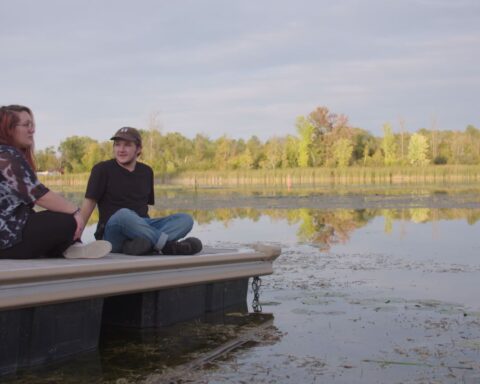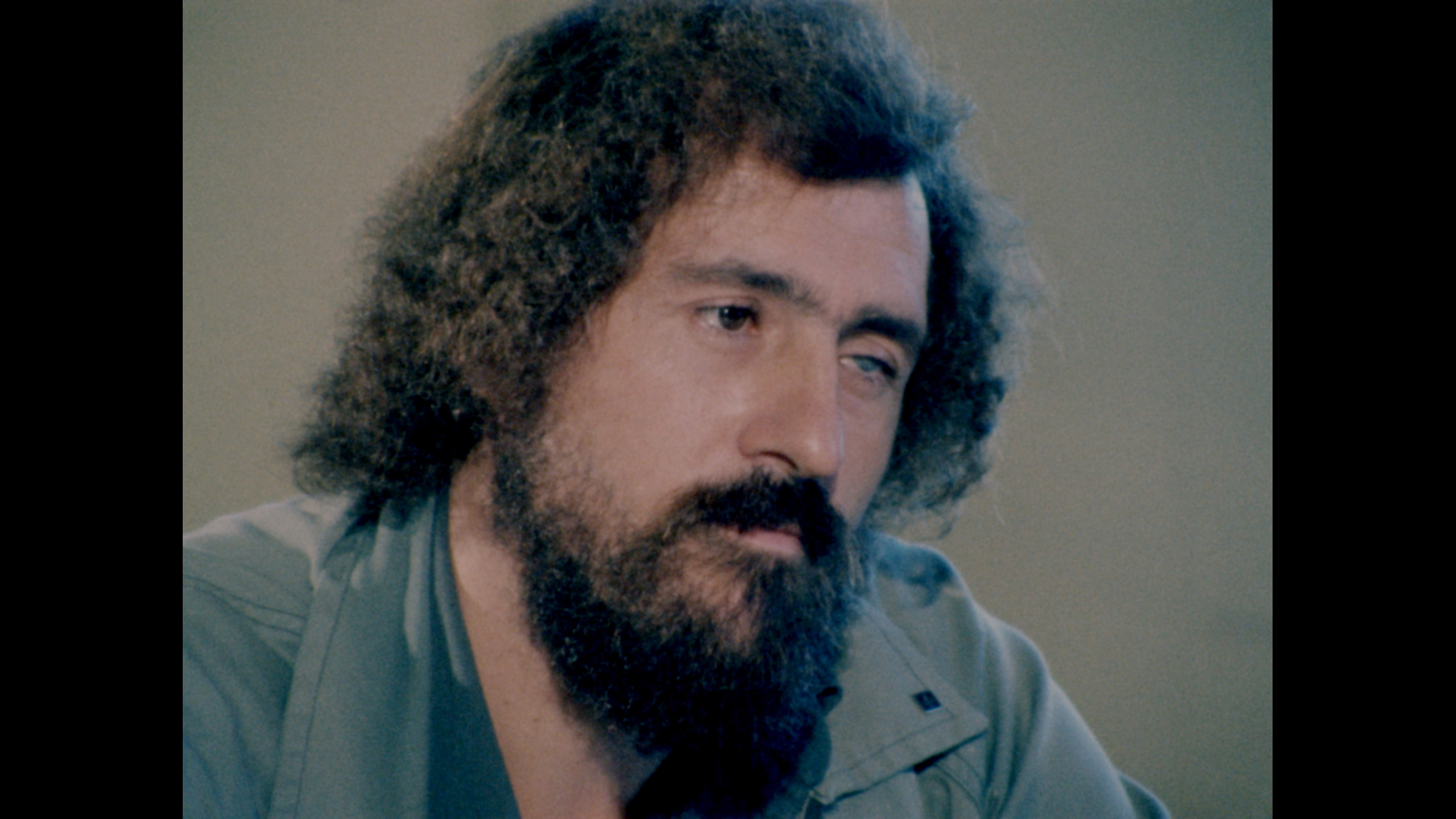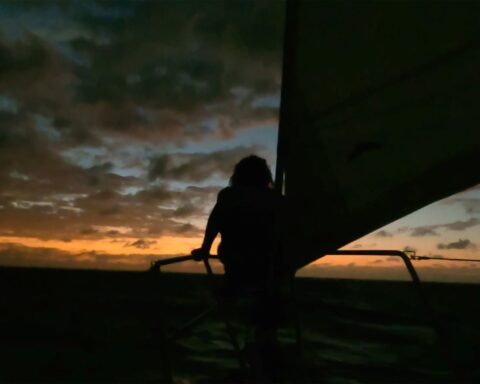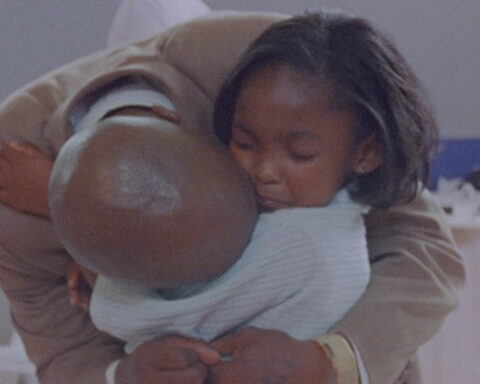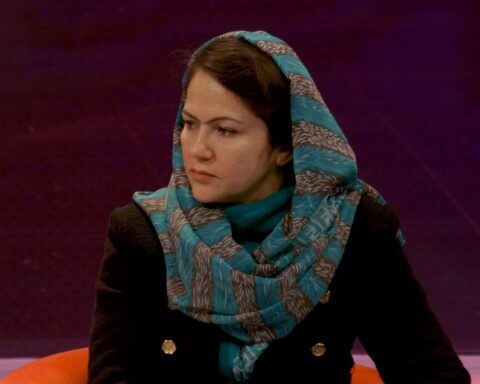Director Adam Benzine finds himself ahead of the curve in the race to deliver a documentary about the coronavirus pandemic. Benzine’s film, appropriately titled The Curve, debuts today on Vimeo and YouTube. It’s the first Canadian feature to tackle the pandemic while other filmmakers both Canadian and international have COVID docs coming down the pipeline.
The Curve focuses on the first 90 days of the virus’s spread in North America. Benzine explains that containing the film to this window was the most logical way to tackle the chaos of 2020 in a coherent and cohesive narrative. Benzine, speaking with POV by phone ahead of the film’s release, says that focusing on COVID-19’s early days in the USA offers a window into the White House’s mishandling of the pandemic. “The mistakes that were made in the first 90 days sealed America’s fate,” observes Benzine.
“The film makes the thesis that that was the point—to act—and that everything afterwards could only be contained to some degree after making those mistakes in the first three months from the arrival of what’s known to be patient zero on January 15 in Seattle through to Easter Monday [April 13] when everything was full-on bedlam.” Throughout these days, people stayed home and watched the crisis unfold via Twitter as celebrities like Tom Hanks and Sophie Grégoire Trudeau caught COVID, proving that the virus was indeed very real. Donald Trump went golfing, shrugged off the virus, and assumed that it would go away if he ignored it.
The first three minutes of The Curve, released earlier this month as a teaser, illustrate how cycles of sexier news stories—like the wildfires in Australia, Donald Trump aberrantly bringing the world to the brink of war, and Parasite’s Oscar win—diverted audiences’ attention from the reality of the pandemic. “Just as the elected officials should have acted in February, we as general public did not have the information that they had,” says Benzine. “In early March, I started to see how serious it was when the numbers started rising. Things started closing down and it was in mid to late March that the idea for the film came about.”
Like many Canadians who figured it was all a matter of riding out a few weeks after panic buying groceries, Benzine saw the lockdown of early March as the wake-up call to pandemic’s reach in North America. “I thought we’d be back to normal by Cannes,” explains Benzine, using the same late-festival festival date that many people in the film world used to gauge the severity of the pandemic.
The First 90 Days
Audiences at the Toronto International Film Festival saw China’s initial response to the early phase of the pandemic in the gripping doc 76 Days, and The Curve provides a sharp contrast. 76 Days, directed by Hao Wu, Weixi Chen, and Anonymous, takes audiences inside the hospitals of Wuhan, China as doctors feverishly worked to contain the virus through early spring. However, by April 14, 2020, the endpoint of The Curve’s narrative, the USA had over 600,000 cases of COVID, with the number of actual cases presumed to be much higher given the Trump administration’s lethargic response.
The Curve acknowledges the dizzying chaos with which Trump and his ship of fools aggravated the situation, like failing to procure enough personal protective equipment (PPE), adopt efficient testing, or, again, acknowledge the problem altogether. “The absolute insanity of the Trump administration brings new chaos every single day,” says Benzine. However, Benzine says he wasn’t concerned with keeping up with the crazy train of Trump. “We don’t try to shock you with any new single revelation,” he explains. “I don’t think that there’s anything new that you can reveal at this point that the Trump administration has done. For the film to have long-term value, we really wanted to have a comprehensive time capture of those first 90 days.”
Whereas one trend among documentaries at this year’s Toronto International Film Festival was obvious signs of “COVID cuts” with filmmakers scrambling to re-edit stories to account for the rapidly changing news cycles during the pandemic, the April 13 cut-off also served a practical function to keep focus. “By tapping into Easter Monday, it allows us to not have to worry about constantly revising the film to add that President Trump said we could inject bleach as a cure for COVID,” says Benzine. “There’s so much that happened just in those first three months that it’s already the case that you can’t include everything.” Like 76 Days, The Curve ironically doesn’t feel dated whereas other films do in trying to keep abreast of the changing news cycles.
A COVID Disaster Movie
Benzine, who is based in Toronto, says that he could have made a film about the Canadian government’s response to the pandemic, but that its actions were too sensible. “There’s no drama there,” laughs Benzine. “Canadians are largely a passive and obedient population in a good way. If the government says that scientists tell us to do something, we do it. We don’t view it as an infringement on our civil liberties to not die.”
The infringement to which Benzine refers relates to the growing politicization of wearing masks, which resulted from mixed messaging from governments, as well as Trump’s own refusal to endorse masks as a necessary precaution to protect oneself and others. Benzine says that these factors, along with making a doc within the production restrictions of COVID, inspired him to treat The Curve like a disaster movie. The drama plays out in a command centre with interviews appearing on a dystopian screen in a dystopian command centre.
The interview footage that appears are conversations that Benzine conducted over Skype, which he assumed would be reshot when travel restrictions lifted. “Before we realized that there would not be any travel again and that this [pandemic] was not going away anytime soon, we decided to use the Skype interviews and treat them in a creative way,” explains Benzine. “We also realized that some of the news footage that we were getting was of lower image quality.
“We digitally treat and embed the interviews into a glass teleprompter upon which our speakers appear,” explains Benzine. “There are various screens of different sizes within the command centre that allow us to put our news footage, stock footage, and interview footage onto different screens and treat them to various degrees.” Audiences only learn of the escalating crisis through the conversations with experts who are patched in to explain the situation.
Production Amid a Pandemic
On one hand, the disaster scenario evokes the raging chaos fuelled by the Trump administration’s ineptitude. On the other, it illustrates how filmmakers are finding creative approaches to working under challenging circumstances that might not yield ideal sounds and images. The seamlessness of the aesthetic incorporates the imperfections into the disaster movie conceit. “It footage seems of lower quality, it’s because it looks like it’s coming in over a transmission and the transmission is a lower quality,” explains Benzine, noting that his creative team, which includes film editor Tiffany Beaudin and composer Joel Goodman, played with any noise or interference in the calls to accentuate the disorienting nature of the developments and the need for information.
Benzine says that the impulse to be creative and efficient with limited resources drew from his experience with his short documentary Claude Lanzmann: Spectres of the Shoah. The film, which Academy Award and Canadian Screen Award nominations, features archival footage and images shot around Paris to complement a key interview with the Shoah director. “We did a significant interview with Claude Lanzmann, and then that had to look very good, but beyond that, we shot some footage in and around Paris, but we used around 90% of what we shot.”
The director sees The Curve and the pandemic as an opportunity for filmmakers to hone their skills and be more efficient. “Since we’ve gone from film to digital, it’s led to a loss of discipline amongst filmmakers who go out there with cameras and shoot everything. They end up with hundreds of hours of footage,” says Benzine. “It’s a waste of man hours. It’s the focus. It’s a waste of resources.” Alternatively, Benzine likens making a doc amid COVID-19 to practices like the Danish movement of Dogme 95 where filmmakers deliberately placed restrictions on their craft in order to inspire creativity. “The Curve is a grand experiment in some ways,” says Benzine, “but even under dire circumstances, documentarians have an obligation to continue to reflect the world around them.” Similarly, the team’s resourcefulness kept everybody safe by using available materials and conducting interviews remotely, rather than sending crews into the field for interviews shoots and B-roll footage.
Disasters Past and Present
The film looks back at several cases that offer learning points to contextualise the disaster. The Curve revisits Trump’s dismantling of the Global Health Security and Biodefense unit, which has obvious consequences from his disastrous decisions in office pre-COVID. Secondly, the doc reflects upon the Ebola virus outbreaks in West Africa in 2014 and takes audiences to Liberia, which had the highest death count. “We speak with Dr. Mosoka Fallah, the director general for the National Public Health Institute of Liberia,” explains Benzine. “He talked through the lessons that were learned and how that helped them to prepare for the COVID crisis arriving in January.”
Finally, The Curve contextualises COVID by revisiting another tragedy that transformed Americans’ lives: the terrorist attacks of September 11, 2001. “9/11 is the last crisis in which the world changed,” says Benzine. While the USA has seen its fair share of tragedies in the years since 2001, life returned to normal fairly quickly. “Other events didn’t fundamentally change life within the country, but 9/11 was a generational change. I think COVID will be like that too. There isn’t really any coming back from this.”
Election Day Looms
The release of The Curve in close proximity to the American oresidential election hopes to inform viewers about Trump’s failings and mobilise progressives to cast their ballots. Benzine doesn’t shy away from noting that the release of the first footage from his film coincided with news that Suzanne Hillinger, Ophelia Harutyunyan, and Oscar winner Alex Gibney’s COVID doc Totally Under Control would also debut leading up to the election. While The Curve looks to the first 90 days of the coronavirus outbreak in North America, Totally Under Control assesses the pandemic specifically through Trump’s failure to respond accordingly throughout the year. However, Benzine sees the interest sparked by Totally Under Control as a “healthy indicator” that an appetite exists for COVID docs long after the election, although a few major distributors shied away from taking on the doc so close to the election.
If anything, the reticence for distributors to get behind a doc like The Curve speaks to the necessity to get it out to audiences. “For a lot of Americans, this virus has come out of nowhere and devastated their lives,” says Benzine. “Their parents have died, their grandparents have died. They’ve lost their jobs. Their whole world has been rocked out of nowhere, and they don’t necessarily really understand why this has happened.”
The Curve screens online in a limited window on Vimeo and YouTube.





